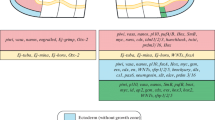Abstract
Regeneration in arthropods and amphibians follows an analogous principle making comparisons between the two phyla possible.
Larval arthropods and amphibians possess powers of epimorphic regeneration which wane for many species of these phyla with the completion of metamorphosis or the cessation of moulting. In those species which retain, post-maturationally, the ability to form a regenerative blastema, larval characteristics are carried into the adult and reproductive stages of these organisms. These include many species of: urodeles, ametabolous insects, crustaceans, myriapods and arachnids. The long-standing distinction between embryonic regulation and “true” epimorphosis would thus appear to be a difference of degree rather than kind.
The thesis presented in these pages, then, is that the ability to post-maturationally regenerate exists as a function of histogenetic juvenilization. Hormonal preadaptation is responsible for the regulatory transcriptional reexpression of larval-like regulation in neoteny, providing the conditions favorable for regeneration in the reproductive stages of these organisms. The pluripotency of blastemal cells can thus be understood as a product of neotenous morphogenesis.
Résumeé
La régénération chez les amphibiens est analogue à celle des arthropodes, permettant la comparaison de ces deux embranchements.
Les arthropodes et les amphibiens larvaires possedent des pouvoirs de régénération épimorphiques qui décroissent, pour plusieurs especes de ces embranchements, lors de l'achèvement de la métamorphose on de la cessation de la mue. Les espèces qui conservent, à postmaturité, la capacité de former un blastème régénératif — e.g., plusieurs espéces d'urodèles, les insectes amétaboles, crustacés, myriapodes, et quelques espèces d'arachnides — ont des caractéristiques larvaires que l'on retrouve également dans les étapes adultes et reproductives de ces organismes. Alors, la distinction entre la régulation embryonnaire et l'épimorphose “réelle”, reconnue depuis longtemps, serait une différence de degré plutôt que de genre.
La thèse énonce que la capacite de régéneration a postmaturité existe en function de l'histogenèse larvaire, La pluripotence des cellules blastématiques peut alors être reconnue comme le product d'une morphogenèse néoténique.
Similar content being viewed by others
References
Bodenstein, D. (1953a). Regeneration. In K.D. Roeder (Ed.), Insect physiology, 866–878. - New York: Wiley.
Bodenstein, D. (1953b). Studies on the Immoral mechanisms in growth and metamorphosis of the cockroach, Periplaneta americana. I. - J. Exp. Zool. 23: 189–232.
Bodenstein, D. (1953c). Studies on the Immoral mechanisms in growth and metamorphosis of the cockroach, Periplaneta americana. II. - J. Exp. Zool. 23: 413–431.
Bodenstein, D. (1955). Contributions to the problem of regeneration in insects. - J. Exp. Zool. 129: 209–224.
Gona, A.G., Pearlman, T., and Gona, O. (1973). Effects of prolactin and thyroxine in hypophysectomized and thyroidectomized red efts of the newt Notophthalmus viridescens. - Gen. Comp. Endocrinol. 20: 107–111.
Goss, R.J. (1969). Principles of regeneration. - New York: Academic Press.
Gould, S.J. (1977). Ontogeny and phylogeny. - Cambridge, Mass.: Harvard University Press.
Hanström, B. (1947). Three principal incretory organs in the animal kingdom. - Copenhagen: Munksgaard.
Juberthie-Jupeau, L. (1979). Data on endocrinology of Symphala (Myriapoda). - In M. Camatini (Ed.), Myriapod biology, 273–278. - New York; Academic Press.
Korneluk, R.G. (1982). Tissue versus epimorphic regeneration in amputated forelimbs of Xenopus froglets and adult newts. - Ph.D thesis (Zool.), University of Toronto.
Kunkel, R.C. (1982). Regeneration. In W.J. Bell and K.G. Adiyodi (Eds.), The American cockroach, 425–443. - New York: Chapman and Hall.
Muneoka, K., and Bryant, S.V. (1982). Evidence that patterning mechanisms in developing and regenerating limbs are the same. - Nature, 298(5872): 369–371.
Needham, A.E. (1965). Regeneration in the Arthropoda and its endocrine control. In V. Kiortsis and H.A.L. Trampusch (Eds.), Regeneration in animals and related problems, 283–322. - Amsterdam: North-Holland.
Oppenheimer, J. (1973). Recapitulation. In: P.P. Weiner (Ed.), Dictionary of the history of ideas, 56–59. - New York: Scribner's.
Pearson, R.D. (1982a). Cellular heterochrony and neoplasia. - Med. Hypoth. 8: 432–436.
Pearson, R.D. (1982b). Amphibian regeneration and cellular heterochrony. - Acta Bioth. 31: 181–184.
Pflugfelder, V.O. (1939). Beeinflussung von Regenerationsvorgängen bei Dixippus morosus Br. durch Extirpation und Transplantation der Corpora allata. - Zeit. Wiss. Zool. 152: 159–184.
Przibram, H. (1926). Tierpropfung. - Braunschweig: Vieweg.
Savory, T. (1977). Arachnida. - New York: Academic Press.
Vorontsova, M.A., and L.D. Liosner (1960) Asexual propagation and regeneration. - New York: Pergamon Press.
Wallace, H. (1981). Vertebrate limb regeneration. New York: Wiley.
Weiss, P. (1939). Principles of development. - New York: Holt & Co.
Wigglesworth, V.B. (1954). The physiology of insect physiology. - London: Methuen.
Author information
Authors and Affiliations
Rights and permissions
About this article
Cite this article
Pearson, R.D. Neotenic blastemal morphogenesis. Acta Biotheor 33, 51–59 (1984). https://doi.org/10.1007/BF00045846
Received:
Revised:
Issue Date:
DOI: https://doi.org/10.1007/BF00045846




